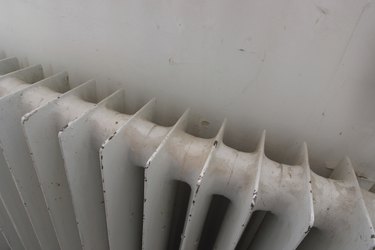Things You'll Need
Adjustable wrench
Large pan
Dish washing liquid
Wire brush
Acetone
Work gloves
Cold-weld epoxy glue

Cast iron radiators can produce reliable heat in buildings for decades at a time but do break down eventually. Since cast iron is such a brittle material, it is prone to cracks. A cracked radiator will begin to leak and allow hot steam or water to escape. This reduces heating efficiency and can pose a physical danger as well. You can repair a cracked, cast iron radiator with an epoxy glue made for use on metal objects.
Step 1
Shut off the radiator's manual control valve. Turn the large knob clockwise until it won't move any further.
Video of the Day
Step 2
Close the lock shield valve at the other end of the radiator. Remove the cap and turn the valve with an adjustable wrench until it stops.
Step 3
Remove all rugs and other furnishings from around the radiator. Place a large pan under the radiator drain valve. The drain valve is typically located at one end of the radiator and is mounted horizontally.
Step 4
Open the radiator drain valve with the adjustable wrench. Allow the water to run out of the radiator and into the pan. Close the valve once the radiator is empty.
Step 5
Clean the area around the hairline crack with dish washing liquid mixed with water. Use a wire brush to scrub off the surface paint, primer or rust around the crack. Wipe the bare metal with acetone to remove oil or other residue.
Step 6
Put on work gloves then mix two-part, cold-weld epoxy glue in a one to one ratio. Apply a thin coat of epoxy to the cracked area. Old House Journal recommends that the epoxy be no more than 1/32-inch in thickness. Allow the epoxy to cure for 15 hours or more before re-opening the radiator valves.
Warning
Remember that the water in the radiator may be hot so take precautions when draining the unit.
Always wear gloves when working with epoxy and avoid wiping your eyes as you're working with it.
Video of the Day